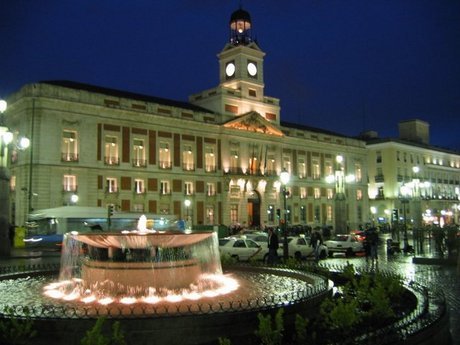Puerta del Sol
This is Madrid's most famous and most central square, located just a short walk from the Plaza Mayor. Originally, it was the site of one of the city's gates, which faced the east and was adorned with an image of the sun, hence the square's name. The square is actually almost semi-circular in shape and owes its current form to the major renovation work carried out between 1854 and 1860.
The Puerta del Sol originated as one of the gates in the city wall that surrounded Madrid in the 15th century. Outside the wall, medieval suburbs began to grow around the Christian Wall of the 12th century. The name of the gate came from the rising sun which decorated the entry, since the gate was oriented to the east.
Between the 17th and 19th centuries, the area was an important meeting place: as the goal for the couriers coming from abroad and other parts of Spain to the Post Office, it was visited by those eager for the latest news. The stairs to the Saint Philip church at the square were known as the Gradas de San Felipe, and were among the most prolific mentideros de la Corte (approx. trans. would be "lie-spreaders of the Court").
The House of the Post Office was built by French Architect Jacques Marquet between 1766 and 1768. The building was the headquarters of the Ministry of Interior and State Security during the Francisco Franco dictatorship. It is currently the seat of the Presidency of the Madrid Community.
If you look to the "flat" south side of the semi circle you will see a clock tower, part of a building known as the "Real Casa de Correos". This was originally built in the 18th century as part of the Post Office, and now functions as the headquarters of the President of Madrid's Autonomous Community.
The clock is the famous clock all Spaniards turn their eyes to on New Year's Eve, guzzling down a grape to each of its twelve chimes at midnight. Millions watch on TV and what sometimes seems like millions more brave the cold here in the square. If you're here on New Year's Eve this is a marvelous experience.
Outside the Casa de Correos is a stone slab on the pavement marking Kilometre Zero - the official starting point for Spain's 6 National Roads.
Directly opposite this building is where until recently (and since 1984) we would expect to see the most important of the 3 statues to be seen in the square, "El Oso y El Madroño" (the Bear and the Strawberry Tree). However, on 25th September 2009, this statue was returned to its original location at the East side of the square, below the famous "Tío Pepe" advert. This was the statue's location when it was placed here in 1967, so it has simply returned home.
The Oso & Madroño is the official symbol of the city although with an unclear origin - it seems that there used to be many bears in the fields around Madrid although the original symbol was supposed to be a female bear (osa). And the strawberry tree seems to be have actually been a hackberry tree (almez), which was once in abundance around Madrid.
Whatever the real history, this bronze statue is the work of the sculptor Antonio Navarro Santa Fe.
The other statues to be found in this square are a reproduction of the Mariblanca statue (the original is in the Municipal Museum) which is believed to be Venus or Diana the Hunter and which marks the spot where previously a fountain stood, and a statue of King Carlos III (placed here by popular demand, since he was called the "Mayor of Madrid" due to the improvements he ordered made to the city).
This is a vibrant part of the city - full of bars, restaurants and shops. Leading off the Puerta del Sol are several streets, amongst which we can name Arenal Street, Calle de Alcalá, Calle Mayor, and Calle Preciados, this last one a pedestrianized street on which large department stores such as El Corte Inglés and FNAC are located, together with international clothes shops such as Zara, H&M, Bershka and many more.
Many old and historic shops selling traditional goods may be found close to this historic square. Smaller boutique type shops for shoes, clothes and other accessories can be found on the nearby Calle del Arenal, Calle Carretas and other surrounding streets.
If you arrive at the metro station at Opera, it is about 5 minutes walk to the entrance of the palace, although you will see it after about 2 minutes walk. Alternatively, if you are coming from the center, around the Plaza Mayor, then you can follow Calle Mayor directly to the palace, which shouldn’t take more than 15 minutes. You can get there via flight to Madrid.




